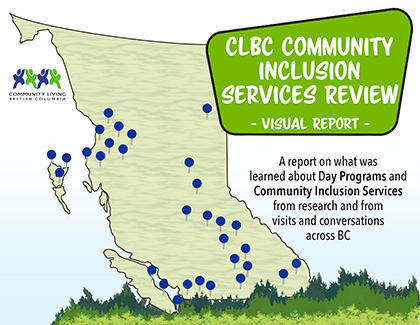 CLBC has published a report on the findings of the Community Inclusion Services Review Project, based on feedback from 650 people receiving community inclusion services, family members and agency staff who deliver services.
CLBC has published a report on the findings of the Community Inclusion Services Review Project, based on feedback from 650 people receiving community inclusion services, family members and agency staff who deliver services.
You can read the Community Inclusion Services Review Report – Executive Summary here.
You can also find a Visual Summary of the Community Inclusion Services Review Report here, and an Easy Read Version of the Community Inclusion Services Review Report here.
About the project
The Community Inclusion Services Review Project studied CLBC funded services commonly referred to as Day Programs and Community Inclusion services. The purpose of the project was to identify Best Practices and recommendations for improving community inclusion services.
What did the project include?
The project began with conversations with self-advocates, family members, professionals, and provincial networks such as the Self Advocate Leadership Network to discuss the direction and purpose of the project.
The next stage was conversations and visits across the province with:
- 41 communities: rural, northern and Indigenous communities and all CLBC regions, both rural areas and urban centers.
- 80+ Day Programs and Community Inclusion service sites.
- 250+ CI program participants.
- 150+ family members and 250+ Community Inclusion service staff.
- 13 community meetings with approximately 300 participants.
- 10 self-advocate groups with more than 60 participants.
- 13 community council meetings with more than 300 participants.
- CLBC’s Board and CLBC’s Editorial Board.
What did we learn?
The project concluded with the following recommendations:
Create a new Community Inclusion Service Policy and develop Best Practice Guides for:
- Choice and Person-Centred Supports Standard
- Meaningful Activity and Social Inclusion Standard
- Pathways to Employment Standard
- Service Quality Outcomes and Monitoring Standard
- Organizational Capacity and Leadership Standard
Create a plan to renew community inclusion services: address service issues, explore new services models, and involve self-advocates in this process.
Examine barriers to community inclusion, such as initiatives related to Truth and Reconciliation Commission (TRC) Calls to Action and equal access to the internet and cell service.
CLBC is currently in the midst of setting its priorities for a new strategic plan, and these findings will be incorporated into the new plan.

